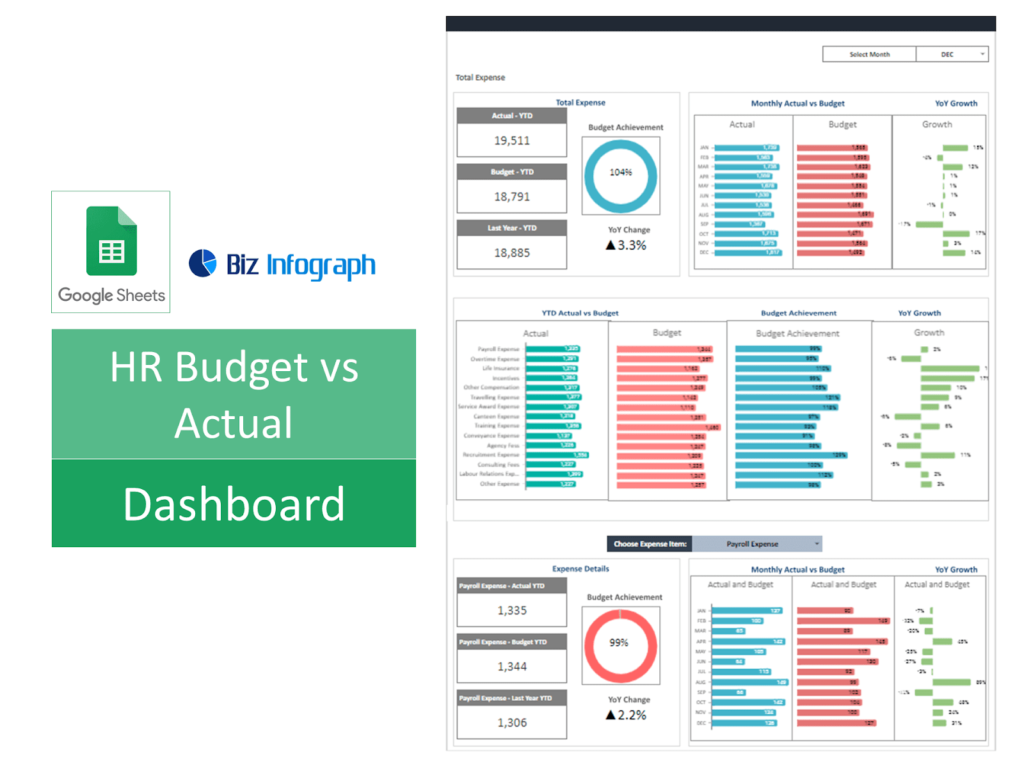Introduction
Financial management plays a role in Human Resources (HR) operations, greatly impacting efficiency and strategic decision making. Effective budget management ensures compliance controls costs and boosts the value delivered by the HR department. The utilization of a comparison tool like an HR Budget vs Actual Dashboard offers a solution that provides an overview of financial data empowering HR managers to monitor and oversee their departments financial well being efficiently.
Understanding the HR Budget vs Actual Dashboard
What is an HR Budget vs Actual Dashboard?
An HR Budget vs Actual Dashboard serves as a instrument that compares planned HR budgets with actual expenses. This dashboard amalgamates data inputs to present real time insights into performance highlighting discrepancies that require attention. It typically showcases metrics visually such as total allocated budget, expenditure details, variance analysis and forecasts based on current spending patterns.
Benefits of Utilizing This Dashboard in Human Resources
This dashboard brings forth advantages including improved transparency, into HR finances, identification of budget inconsistencies and the ability to make prompt informed decisions.
By monitoring these metrics HR departments can ensure that financial goals are achieved and can proactively address any overspending or underutilization of resources.
Essential Features of a HR Budget Dashboard
Real Time Budget Tracking
monitoring is essential, in todays fast paced business environment. A designed HR Budget vs Actual Dashboard updates information in real time enabling HR managers to view current expenditures compared to the budget at any given moment. This immediate insight is crucial for addressing any discrepancies that may impact the overall budget.
Comprehensive Breakdown of Budget vs Actual Expenditure
A breakdown of expenses allows HR managers to delve into areas of expenditure. This may involve categorizations such as recruitment expenses, employee training costs, benefits administration and more. Understanding where funds are allocated and how these numbers stack up against the budget aids in identifying areas of inefficiency or unexpected cost savings. Use the ready template from Biz Infograph to reduce reporting time and ensure accuracy.
Setting Up Your HR Budget vs Actual Dashboard
Deciding Which Metrics to Monitor
The core of a HR Budget, vs Actual Dashboard lies in choosing the metrics that accurately reflect the organizations strategic objectives and financial targets. Key performance indicators commonly tracked include the cost, per hire, which aids in gauging the effectiveness of the hiring process; training expenses per employee which assesses investments in skill development; benefits as a portion of salaries, which gauges the competitiveness and sustainability of employee perks; and turnover expenses, which shed light on the implications of employee turnover. Each metric chosen should offer insights to steer HR activities towards not monitoring costs but also driving strategic enhancements.
Seamlessly integrating the HR Budget vs Actual Dashboard with HR systems like payroll processing, benefits management and employee databases is essential for maximizing its utility. This integration streamlines data flow into the dashboard boosting data accuracy and minimizing risks linked to data input. A smooth integration ensures that HR managers have access to reliable data for making decisions promptly.
Leveraging Your Dashboard for Identifying Cost Efficiency
Uncovering Patterns and Exceptions
A benefit of using an HR Budget, vs Actual Dashboard is its capability to uncover spending trends and irregularities that might otherwise remain unnoticed. By examining spending trends HR managers can identify discrepancies. Pinpoint potential inefficiencies.
For instance if there’s a trend of overspending in a quarter it could indicate the necessity, for improved budgeting or prompt a review of vendor contracts to negotiate better terms. Recognizing these trends helps in managing expenses. Maintaining financial discipline within the HR department.
Responding to Data Insights
The data offered by the HR Budget vs Actual Dashboard empowers HR managers to make adjustments to address financial discrepancies. With data on hand managers can make educated decisions on reallocating budget resources to support impactful HR initiatives. Adjustments may involve refining recruitment approaches to lower hiring costs reallocating funds towards enhancing training programs with ROI or optimizing benefits packages to better align with employee needs while adhering to budget constraints. These strategic choices aid not in cost control. Also enhance overall organizational efficiency.
Improving Decision Making through Strategic Understanding
Proactive Financial Planning
Equipped with insights from the HR Budget, vs Actual Dashboard HR professionals can shift from reactive to financial management. This proactive stance enables HR departments to anticipate hurdles and opportunities facilitating strategic planning that bolsters long term financial stability and organizational advancement. Regular reviews, whether on an quarterly basis can play a role, in detecting and rectifying any irregularities in data early on ensuring that financial choices are grounded on the most up to date and precise information.
Training employees to effectively utilize the dashboard is essential for it to serve as a resource for the organization. It is important not to teach staff how to navigate the dashboard also how to analyze the data it presents. Investing in training initiatives can enhance the usefulness of the dashboard by transforming data into insights that foster organizational success.
In summary
An HR Budget vs Actual Dashboard proves to be a tool for optimizing efficiency within HR operations. By offering time insights into budget performance and seamlessly integrating with existing HR platforms this dashboard empowers HR professionals to make well informed financial decisions ensure adherence, to budgetary constraints and contribute strategically towards the overarching objectives of the organization. Implementation of such a dashboard has the potential to revolutionize management practices in HR by promoting strategic decision making driven by data and ultimately leading to greater organizational efficiency.

